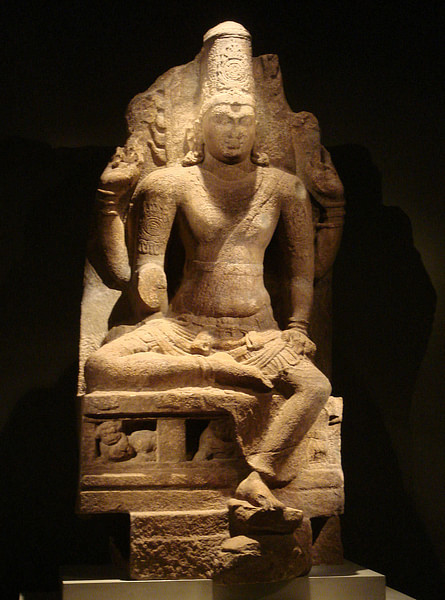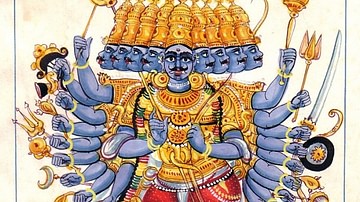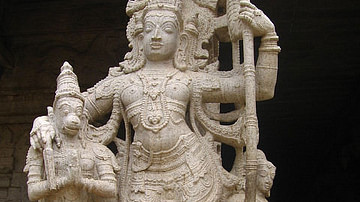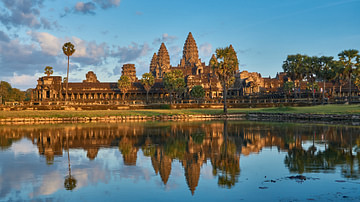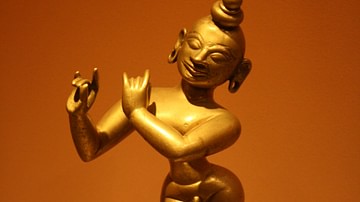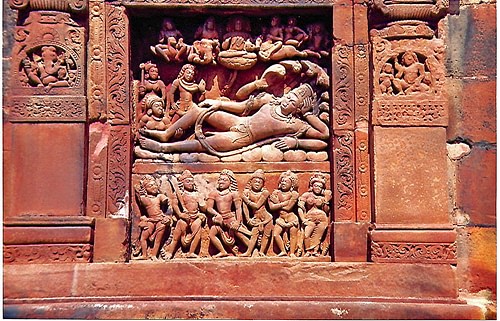
Vishnu is one of the most important gods in the Hindu pantheon. He is considered a member of the holy trinity (trimurti) of Hinduism with Brahma and Shiva. Vishnu is the Preserver and guardian of men, he protects the order of things (dharma), and he appears on earth in various incarnations (avatars) to fight demons and to maintain cosmic harmony.
Vishnu is the most important god of Vaishnavism, the largest Hindu sect. Indeed, to illustrate Vishnu's superior status, Brahma is, in some accounts, considered to have been born from a lotus flower which grew from Vishnu's naval. Vishnu was married to Lakshmi (the goddess of good fortune), Sarawati (the goddess of wisdom) and Ganga (the goddess who is the personification of the River Ganges). However, unable to live with the quarrels between his three wives, Vishnu eventually sent Ganga to Shiva and Sarawati to Brahma. In some accounts, another wife of Vishnu's is Bhumi-Devi (goddess of the Earth). He is considered to live in the city of Vaikuntha on Mt. Meru, where everything is made of shining gold and fabulous jewels and where there are lakes resplendent with lotus flowers.
The 10 Avatars of Vishnu
Vishnu has ten avatars or worldly appearances, which are people, animals or a mix of both. Vishnu's ten avatars are:
- Buddha
- Krishna (the hero)
- Rama (the hero)
- Parashurama (the hero)
- Nara-Simha or Narasimba (the man-lion)
- Vamana (the dwarf)
- Matsya (the fish)
- Kurma (the tortoise)
- Varaha (the boar)
- Kalki (who will appear when the world ends, riding a white horse and heralding the start of a new golden age)
Like any major god, Vishnu is involved in a number of colourful stories which illustrate his virtues as the protector of cosmic order. As Varaha, the gigantic boar, he defeated the giant Daitya after Hiranyaksha had mischievously taken the Earth (Bhumi-devi) to the bottom of the sea. The incredible fight between the two lasted for a thousand years but Vishnu prevailed and finally raised the Earth from the watery depths, carrying it on his tusk.
Vishnu in Mythology
In the Bhagavata Purana, an epic poem that collects together many Vaishnavite stories, Vishnu is also credited with giving all the other gods the gift of immortality. The story goes that the gods wanted to churn up the ocean of milk in order to create the nectar (amrita) which gave its drinker eternal life. To mix the ocean they decided to use the holy Mt. Mandara with the giant serpent Vasuki (or Ananta) as a turning rope; one end to be pulled by Demons and the other by the gods. However, neither group could handle such a weight and they called for Vishnu to hold it. This he did in the form of Kurma, the giant tortoise, supporting the mountain on his shell. The nectar was duly created from the foaming sea but the Demons, true to character, tried to make off with it. Fortunately, Vishnu interceded in the form of the beautiful Maya (the personification of Illusion) and, suitably distracted, the Demons relinquished the nectar which Vishnu graciously gave to the gods, allowing them the possibility of immortality.
Vishnu appears as another avatar in the form of the fish Matsya. Manu, the sage and son of Vivsavat-Sun, was washing in a river one day when a small fish suddenly jumped into his hand. About to throw the fish back into the water, he was stopped by the pleadings of the fish, who was afraid of the monsters that might eat him. Manu, therefore, kept the fish in a small bowl but, overnight, the fish grew bigger and so had to be moved to a jar. Still the fish kept growing and so Manu threw it into a lake. However, the fish continued to grow and reached such a prodigious size that Manu was obliged to put it into the sea. The fish then made a prophecy that in seven days there would be a great flood but Manu was not to worry about this catastrophe as the fish would send him a large boat so that he might escape unharmed. The fish instructed Manu to fill the boat with pairs of all the creatures of the world and seeds of all the plants and, during the flood, to tie his boat to the fish by using a giant snake - Vasuki. After some time, just as the fish had predicted, the ocean slowly and relentlessly rose up and flooded the world. Vishnu then reappeared on the scene as the gigantic fish, this time with golden scales and a single horn, and carrying the promised ship for Manu. The sage promptly boarded with his vast collection of animals and so, by surviving the flood, became the founder of the human race.
The three previously mentioned avatars of Vishnu all appeared in the first creation stage of the kalpa - or worldly cycle, of which each breath of the god is one cycle. The next stage involved the battle with demons for control of the world. Here Vishnu appeared as both the hero Rama, who had many adventures fighting rakshasas and as the axe-wielding monk, Parasurama, who fought the kshatriyas.
The Legend of the Three Steps
One of the more famous episodes involving the god in this second phase of the world is the Legend of the Three Steps. In the battle between gods and giants for control of the world, the latter were gaining the upper hand. However, Vishnu was persuaded by the gods to interrupt his meditations and confront the giant warrior Bali, which he did in the form of a dwarf Brahman (or priest) called Vamana. Vishnu offered a compromise: if the fighting stopped, the gods would settle for a small territory covered by three of Vamana's steps and the giants could have the rest of the universe. Looking at the tiny legs of the dwarf, this seemed a good bargain and so Bali agreed. The dwarf was really of course a great god though and with his first step he cleared the sky, with the second the Earth and, with his final step, the Underworld, thus leaving nothing for the poor giants. For this reason, Vishnu is often also called Trivikrama, meaning 'of the three steps'. The story may also represent the three movements of the sun: rise, zenith and setting. Certainly, Vishnu was associated with the sun, as one of his other names suggests - Surya Narayana.
As a warning to unbelievers, Vishnu appeared as the man-lion Nara-Simha when Hiranya-Kasipu (King of the Asuras or Demons) not only impiously called for people to worship him as a god but also foolishly challenged Vishnu to show himself there and then if the god really were omnipresent. Lo and behold, Vishnu immediately leapt from a nearby column and, in the form of a ferocious lion, ripped the unbeliever to pieces with his claws and made a fearsome necklace of his entrails. Compelling evidence indeed, of the dangers of impiety.
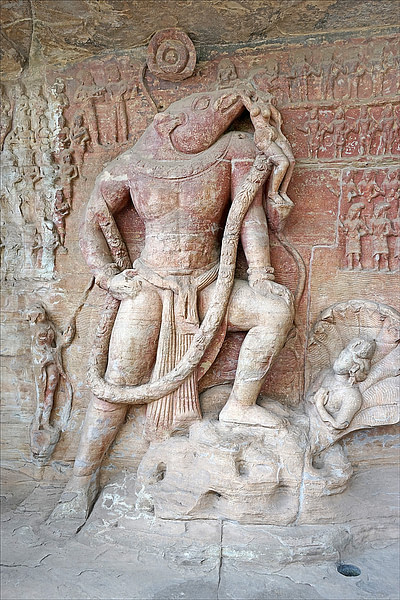
In the third phase of the kalpa, Vishnu appeared as Buddha and Krishna, both important figures in their own right. Krishna, or the 'Black Prince', was reared in the forests by cowherds after his mother, Devaki, feared for the safety of her eighth child after his uncle Kamsa had received a prophesy that he would be killed by his eighth nephew. Brought up by the shepherd Nanda and his wife, the young Krishna already displayed his divine capabilities by performing prodigious feats of strength and he also killed many demons and monsters. He was, perhaps unsurprisingly, also greatly admired by the ladies of the forest. However, this idyllic existence came to an abrupt end when his mother cursed her son for not having intervened in the great battle between the warring families of the Kurus and Pandus (although Krishna was, in fact, present at the Battle of Kurukshetra in the form of Prince Arjuna's charioteer, as told in The Bhagavad-Gita). Consequently, while peacefully meditating one day, he was struck by a wayward arrow from a hapless hunter and alas the arrow hit his one weak spot - his heel. It was said that to mark such a sad end to such a popular figure, even the sun itself died with him.
How is Vishnu Representated in Art?
In Hindu art Vishnu is variously portrayed depending on specific cultures in South Asia and Southeast Asia - Indian, Cambodian, Javanese etc. but he is most often depicted coloured blue and sometimes rides Garuda, a gigantic half-man, half-bird creature which devours snakes. On occasion he sleeps on the giant snake Sesha (or Ananta), whose seven heads form a canopy over the god. His weapon is the Sudarsanacakra or discus (chakra), perhaps representative of his association with the sun but also, with its thousand spokes, symbolic of the wheel of time. He often holds various other objects in his (usually) four hands such as a conch shell trumpet which sounds the Creation, a mace (gada) or a sword which represents strength, and a lotus, representing freedom and the beauty of life.
